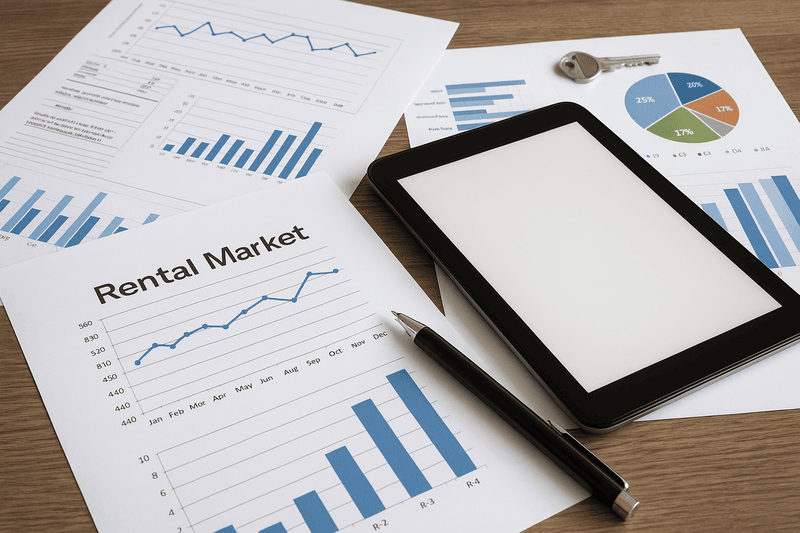
For landlords trying to stay competitive in a fast-changing market, making decisions based on assumptions or old data isn’t just risky—it can cost you real income. That’s where Rental Reports come into play. Whether you’re a first-time investor or managing multiple properties, these reports offer real-time insights that help you price smarter, screen tenants more effectively, and understand your suburb’s rental trends.
But what exactly are these reports, what should you expect from them, and how can they make a real difference to your bottom line? Here’s everything you need to know about how smart landlords are using data to their advantage.
What Are Rental Reports?
A Rental Report is a data-driven summary that provides insights into current rental market conditions. These reports typically include:
- Median weekly rents by property type
- Vacancy rates and leasing durations
- Suburb or postcode-level rental trends
- Historical comparisons over previous quarters
- Demand metrics (e.g., number of applicants per property)
- Suggested rental ranges for specific property types
These details allow landlords to better understand how their property stacks up against local competition and help avoid overpricing (leading to vacancies) or underpricing (leading to lost revenue).
Rental Reports from trusted agencies like West Realty offer a free, easy-to-read breakdown for suburbs across Victoria—helping investors make decisions grounded in data, not guesswork.
Why Rental Reports Are Crucial for Landlords
- Get Accurate Pricing Recommendations
Incorrect pricing is one of the leading reasons rental properties stay vacant. A difference of just $10 to $20 per week can significantly affect your vacancy period or yield. Reports can help you pinpoint an accurate range based on current demand and supply. - Spot Market Trends Early
Are rental prices softening? Is your area becoming more competitive? Rental reports often highlight emerging trends like rising vacancies, sudden rent hikes, or tenant movement patterns that you might otherwise miss until it’s too late to respond. - Support Tenant Negotiations
If a tenant requests a rent reduction or you’re negotiating a renewal, citing facts from current rental data gives you a strong position. Rather than relying on generalised knowledge, you’ll have figures to support your offer or counter-proposal. - Justify Rent Increases Legally and Logically
In many states, including Victoria, rent increases must be fair and justifiable. By referencing up-to-date Rental Reports, you can clearly demonstrate your pricing aligns with the broader market—a safeguard for both landlord and tenant.
For those looking to streamline decision-making, West Realty’s Landlord Resources section provides helpful, free downloadable reports tailored to key areas like Melton, Caroline Springs, and Bacchus Marsh.
What Makes a Good Rental Report?
Not all rental data is equally useful. Look for reports that:
- Are updated quarterly or monthly
- Include localised information (postcode or suburb level)
- Offer rental trends per property type (e.g., 2-bed unit vs 4-bed house)
- Include both historical and current performance comparisons
- Are presented in a clear, visual format (graphs or tables help)
Reports like these not only help with rental pricing but are often used as part of long-term planning for upgrades, renovations, or portfolio expansion.
Common Mistakes Landlords Make Without Using Reports
Setting rent based on ‘gut feel’
Your property might have sentimental value, but the market doesn’t care about emotion. Using your own expectations to price a property often leads to overpricing and extended vacancy periods.
Relying on real estate listings alone
Listings show asking prices, not achieved rents. Rental Reports show what properties actually rented for, which is a more reliable guide.
Failing to adjust during market changes
The rental market fluctuates with interest rates, migration patterns, and economic conditions. What worked six months ago may not hold up today.
These pitfalls are commonly discussed by investors on Blogrip—a helpful community where users frequently share lessons from both successful and failed rental strategies.
How Can You Use Rental Reports Strategically?
- During Lease Renewals
Before offering a new lease term, refer to the most recent market data. If demand has risen, a moderate increase may be justifiable. If it’s softened, retaining a good tenant may be worth holding the current rate. - When Listing a Vacant Property
Combine your property’s features (e.g., location, bedrooms, condition) with data from Free Rental Market Reports to determine your pricing. Adjust for features like renovated kitchens or included utilities. - Planning Upgrades
Some upgrades (air conditioning, additional bathrooms, covered parking) may increase rentability significantly. Rental Reports help you calculate whether the cost of upgrades can be recouped through higher rent. - Evaluating Investment Opportunities
Before purchasing a property, compare its expected rental income with data from that suburb’s report. You’ll be able to more accurately calculate ROI and avoid overpaying for a poor performer.
How Often Should You Check Reports?
Every quarter is a solid baseline, particularly in dynamic markets like Melbourne’s outer suburbs. However, landlords operating in high-turnover areas or those looking to grow their portfolios may benefit from checking monthly trends.
For instance, some regions in Victoria have seen a 15% increase in median rents over 12 months, while others have flattened. Regular access to reports via the Rental Reports page allows landlords to respond to these shifts with speed and accuracy.
Where to Access Reliable Reports for Free
Many agencies charge for detailed suburb reports or require you to sign up to a service. However, West Realty provides Free Rental Market Reports that are downloadable and specific to key growth areas across Western Melbourne. These reports are backed by local data and crafted by experienced property managers who understand both macro and micro trends.
This level of granularity is rare in free resources and makes the reports an ideal starting point for landlords who want clarity without the complexity.
Final Thoughts
Property investment isn’t passive—it demands awareness, action, and good information. Rental Reports are no longer a ‘nice-to-have’—they’re essential tools for staying competitive, reducing risk, and maximising returns. Whether you’re looking to adjust rent, plan improvements, or expand your portfolio, reports give you the confidence to move forward with clarity.
To access your suburb’s latest data, head to Rental Reports and explore their regularly updated insights. Backed by local experts, these free resources help landlords make smarter decisions based on real numbers, not outdated assumptions.
If you’re interested in more DIY property management tools, you’ll also find some great discussions on landlord checklists and maintenance tips at Blogrip, where landlords swap strategies that work.

Leave a Reply